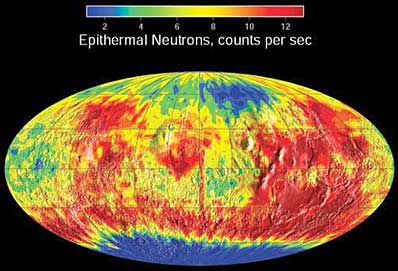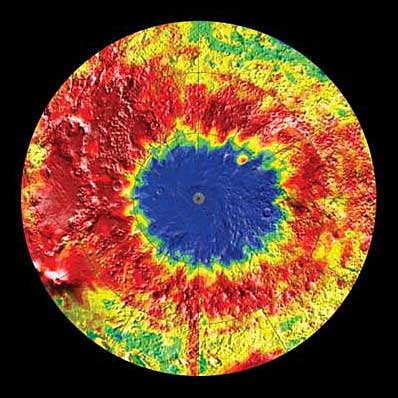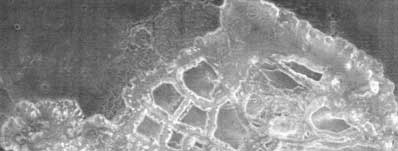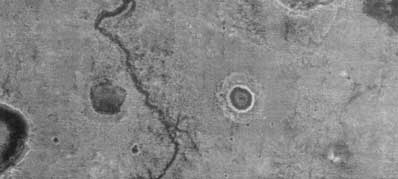
Mars Odyssey detects evidence of water ice
BY JEFF FOUST
SPACEFLIGHT NOW
Posted: March 1, 2002
In its first major discovery since entering orbit, NASA's Mars Odyssey spacecraft has detected evidence of extensive amounts of water ice below the surface of the Red Planet, scientists announced Friday.

Observations by NASA's 2001 Mars Odyssey show a global view of Mars in intermediate-energy, or epithermal, neutrons. Soil enriched in hydrogen is indicated by the deep blue colors on the map, which show a low intensity of epithermal neutrons. The view shown here is a map of measurements made during the first week of mapping by NASA's 2001 Mars Odyssey spacecraft in February 2002 using the neutron spectrometer instrument. The central meridian in this projection is zero degrees longitude. Credit: NASA/JPL/University of Arizona
|
Preliminary results from the gamma ray spectrometer (GRS) instrument, one of three main instruments on Mars Odyssey, indicate that there may be a significant amount of water ice within about a meter of the surface in the vicinity of the south pole of the planet.
"The preliminary assessment of the gamma-ray spectrometer data indicates the likely presence of hydrogen in the upper few feet of the Martian surface, as sampled at spatial scales approximately 400 miles across," said Jim Garvin, lead scientist of NASA's Mars exploration program, in a statement.
That conclusion comes from an analysis of data from the various detectors on GRS that measure gamma-ray and neutron emissions from the surface of Mars, created when cosmic rays collide with the surface. The spectra of gamma rays emitted from the surface shows a strong peak at a specific frequency corresponding with gamma rays emitted by hydrogen atoms when they absorb neutrons. Neutron detectors on GRS show a corresponding decrease in medium- and high-speed neutron emissions from the planet, which is consistent with hydrogen atoms slowing down and absorbing the neutrons.

South Pole neutron view. Credit: NASA/JPL/University of Arizona
|
The GRS data do not directly prove the existence of water, but instead indicate the presence of hydrogen within the top meter of so of the Martian surface. The most likely source of that hydrogen, however, is water ice. The discovery is similar to one made in 1998 by a similar instrument on Lunar Prospector, which detected evidence of hydrogen, and presumably water ice, in permanently shadowed regions of craters at the Moon's poles.
There is still too little data to measure exactly how much water ice there may be on Mars, but the impression scientists gave is that there may be significant amounts of it. "There is a lot of ice on Mars," said William Boynton, principal investigator on GRS, at a press conference where the results were announced. To date the ice appears limited to areas south of 60 degrees south latitude, but Boynton said a similar area may exist in the north polar regions, currently hidden from view by a carbon dioxide ice cap during northern winter.
Boynton said getting any data was surprising at this early juncture of the mission, since the GRS is still near the spacecraft, which interferes with the instrument's operation to some degree. In one to two months the six-meter boom on which the GRS is mounted will be extended, allowing the instrument to more clearly study the surface. Boynton said that stronger than expected signals from the surface are allowing them to do these studies with the boom still retracted.

This nighttime infrared image, taken by the thermal emission imaging system, captures a massively disrupted region on Mars called Hydaspsis Chaos, which is located near the equator at two degrees north, 29 degrees west. The total vertical difference from the lowest to highest points in this region is about five kilometers (three miles). The steep slopes leading down into the canyon of Hydaspsis Chaos are strewn with rocks, while the plateaus and mesas above are covered in dust. This pattern indicates that processes are at work to prevent the dust from completely covering the surface of these slopes, even over the very long period since these canyons were formed. Credit: NASA/JPL/Arizona State University
|
The first images of the Martian surface taken with Mars Odyssey's Thermal Emission Imaging System (THEMIS) were released Friday as well. THEMIS is able to observe the surface at visible and infrared wavelengths, including the ability to take images of the surface at night. The thermal infrared images allow scientists to, among other things, tell the difference between rocks, which have relatively small temperature swings, and dust and sand, which warm up more during the day and cool off more at night.
Philip Christensen, the principal investigator of THEMIS, praised the "amazing clarity and crispness" of the images. "The diversity we see here is really striking," he said. "This will truly allow us to peer into the dark recesses of Mars."

This nighttime thermal infrared image shows differences in temperature that are due to differences in the abundance of rocks, sand and dust on the surface. Rocks remain warm at night, as seen in the warm (bright) rim of the five-kilometer- (three-mile-) diameter crater located on the right of this image. The sinuous channel floor is cold, suggesting that it is covered by material that is more finely grained than the surrounding plains. The interior of the crater shows a great deal of thermal structure, indicating that the distribution of rocks, sand and dust varies across the floor. The presence of rocks on the rim and inner wall indicates that this crater maintains some of its original character, despite erosion and deposition by Martian winds. Nighttime infrared images such as this one will greatly aid in mapping the physical properties of Mars' surface. Credit: NASA/JPL/Arizona State University
|
The third major instrument on Mars Odyssey is the Martian Radiation Environment Experiment (MARIE). The instrument collected data on the cosmic radiation environment while en route to Mars, but suffered a communications problem in August and has not returned any data since then. The data that MARIE did return showed that astronauts on a journey to Mars would experience about twice the radiation dose that they would receive staying on the International Space Station.
Engineers do not known the cause of the problem with MARIE, but with the spacecraft now safely in orbit and operating normally plan to spend the next couple of weeks doing more extensive troubleshooting. "We've tried all the easy things to get MARIE working," said Mars Odyssey project scientist Steve Saunders, "but we have not run out of things to try."

This global map of Mars shows the estimated radiation dosages from cosmic rays reaching the surface, a serious health concern for any future human exploration of the planet. The estimates are based on cosmic-radiation measurements by the Mars radiation environment experiment, an instrument on NASA's Mars 2001 Odyssey spacecraft, plus information about Mars' surface elevations from the laser altimeter instrument on NASA's Mars Global Surveyor. The areas of Mars expected to have the lowest levels of cosmic radiation are where the elevation is lowest, because those areas have more atmosphere above them to block out some of the radiation. Earth's thick atmosphere shields us from most cosmic radiation, but Mars has a much thinner atmosphere than we have on Earth. Credit: NASA/JPL/JSC
|
Friday's results were only the beginning of a cornucopia of data that scientists are expecting from Mars Odyssey over the next several years. Project officials say the spacecraft is in good health and should be able to study the planet for the next two Martian years, or more than three and a half Earth years.
The results were especially satisfying to scientists like Boynton, who has been working to fly a gamma-ray spectrometer to Mars since the mid 1980s. A similar instrument was included on Mars Observer, a spacecraft that was lost days before it was to enter orbit around Mars in 1993. While other instruments on Mars Observer were reflown on Mars Global Surveyor and the ill-fated Mars Climate Orbiter, GRS did not get a chance to return until Mars Odyssey. "I almost feel like I've been on my own odyssey," he said.

|
 |
 |
 |









|

